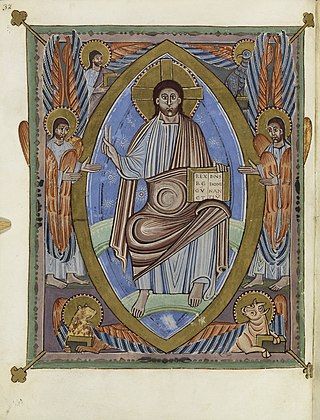Top Qs
Timeline
Chat
Perspective
Tyniec Sacramentarium
From Wikipedia, the free encyclopedia
Remove ads
The Tyniec Sacramentary is an Ottonian illuminated manuscript written in c. 1072–1075, probably near Cologne.[3]
Remove ads
History
Summarize
Perspective
It is one of the oldest surviving codices in Poland, where it first arrived during the Middle Ages, kept in Poland for almost 1,000 years.[3] It was transcribed and decorated with illuminations in Cologne, probably at the Monastery of St Pantaleon around 1072–75.[3] Shortly afterwards or in the 12th century it was offered to the Benedictine Abbey in Tyniec near Kraków.[3] It was stolen during the Swedish invasion in the 17th century.[2] Repurchased in Kraków, it returned to Tyniec.[2] In 1814 the manuscript was bought from the monks by Stanisław Kostka Zamoyski and included in the library of the Zamoyski family in the Blue Palace in Warsaw.[2][3]
During World War II the Nazis tried to take the manuscript to Berlin, but thanks to the endeavours of librarians, scholars and diplomats, they left it in the Zamoyski Library.[2] After the Warsaw Uprising the manuscript was secretly evacuated and hidden in the collegiate church at Łowicz.[2] After the war in 1946, Jan Zamoyski, the final owner of the Zamoyski family fee tail, deposited the family library with the National Library of Poland.[3][2] Since May 2024, the manuscript has been exhibited at the permanent exhibition in the Palace of the Commonwealth in Warsaw.[4][3]
Remove ads
Description
The Sacramentary contains prayers for the priest celebrating Mass.[2] Magnificently decorated, it is one of the most precious artefacts of the Ottonian manuscript painting school.[2][3][5] The sumptuous form of The Sacramentary indicates that the codex belonged to the so-called king’s manuscripts, which reflected the monarchy’s splendour.[2]
The manuscript consists of 470 pages.[2] 38 of them is written in gold and silver on purple-stained parchment pages.[3][2] Pages 7–30 contains a calendar.[1] The manuscript contains 13 decorated initials (two full-page plaited initials) and two fullpage miniatures – the Crucifixion and the Maiestas Domini.[2][3] It also contains the oldest musical notation in Poland in chironomic form.[2]
Remove ads
References
Bibliography
External links
Wikiwand - on
Seamless Wikipedia browsing. On steroids.
Remove ads

